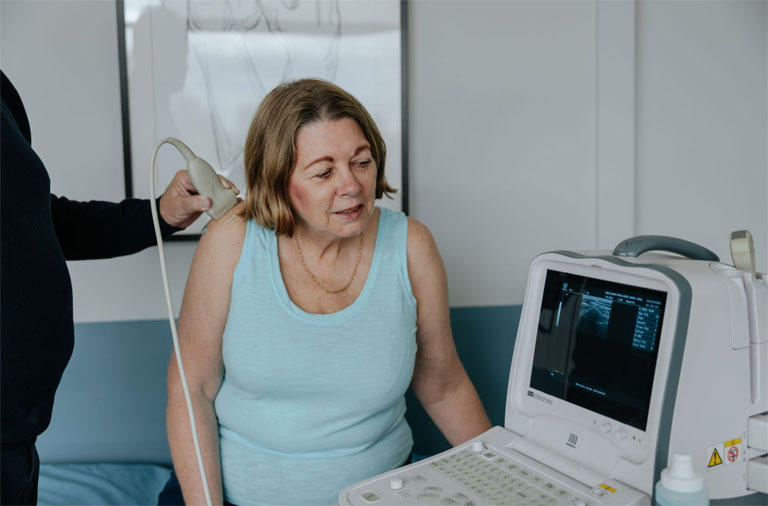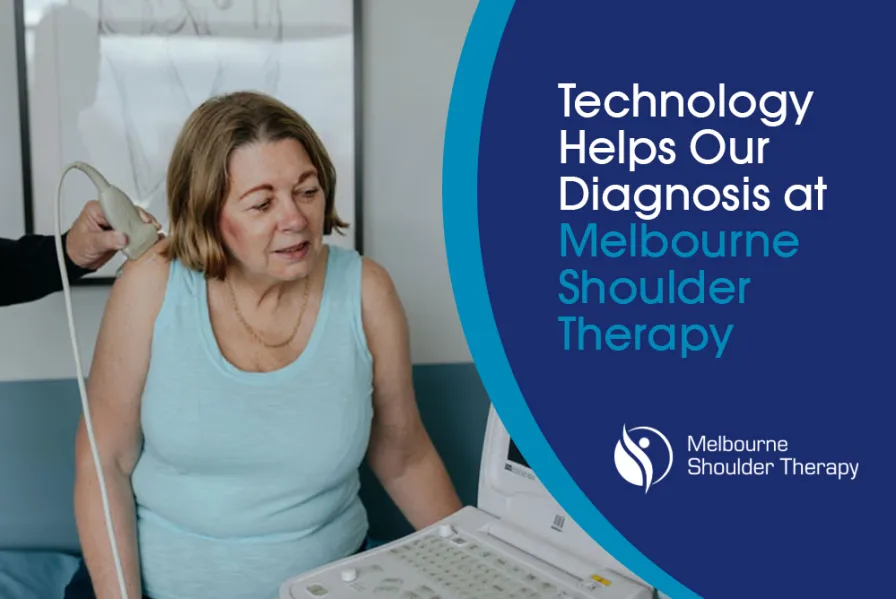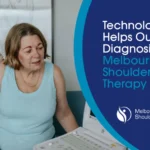At Melbourne Shoulder Therapy, technology helps our diagnosis.
We use real-time ultrasound to visualise what is happening inside your shoulder.
Ultrasound can determine if the rotator cuff is torn, or whether there is tendinopathy causing the pain.
It can inform us of a distended subacromial bursa, which occurs with inflammatory bursitis.
Ultrasound takes the guesswork out of our assessments and provides greater confidence in our diagnoses.

However, ultrasound should not be used in isolation.
At Melbourne Shoulder Therapy, we are looking for harmony between the story that the patient tells, the physical examination, and the ultrasound results.
All three elements of the examination need to be consistent.
Testing the strength of the shoulder muscles is a critical element of shoulder assessment.
To ensure that we have accurate and reliable results from our strength testing, we use dynamometry.
This utilises a portable, handheld device and provides accurate results for the strength of various shoulder movements.
Again, it takes the guesswork out of assessment and allows for meaningful evaluation of the patient’s progress in rehabilitation.
We have developed a reliable protocol for strength testing at Melbourne Shoulder Therapy.
Through a long period of strength testing around the shoulder, we have developed expected readings for different “healthy” populations.
This allows us to better understand your strength readings and establish realistic goals for your recovery.
How Does My Shoulder Blade Affect My Shoulder Pain?
The way your shoulder blade (scapula) moves can be responsible for your shoulder pain.

When the shoulder blade is not moving as it should, it’s called scapular dyskinesis.
When the arm is moved upwards, the shoulder blade moves in a way to assist that upward movement.
When the shoulder blade is not moving correctly, the rotator cuff tendons can be irritated or compressed, leading to shoulder pain.
This is because the roof of the shoulder is an extension of the shoulder blade, called the acromion.
If the shoulder blade is not moving correctly and scapular dyskinesis is occurring, the distance between the acromion and the top of the humerus (the arm bone) may be reduced, which then compresses the rotator cuff and the subacromial bursa.
At Melbourne Shoulder Therapy, when we assess your shoulder movements we pay close attention to the way the shoulder blade is moving, to diagnose any scapula dyskinesis that may be in operation.
Part of your treatment routine for rotator cuff pain or bursitis may involve re-education of your shoulder blade movements.
It may also involve strengthening and stretching certain muscles around the shoulder blade.
The shoulder blade can be seen as both the base and the roof of the shoulder, because it contains the shoulder socket (glenoid fossa).
This highlights how important the shoulder blade is for normal shoulder function — and how critical it is to successful shoulder rehabilitation.
When Is Shoulder Pain Not Shoulder Pain?
When it comes from your neck.

The location of your pain can sometimes tell you where it’s originating.
If your pain is located between the neck and the shoulder, it’s likely that it’s coming from the neck, not the shoulder.
The shoulder does not refer pain upwards toward the neck.
-
Rotator cuff issues (tears or tendinopathy) usually cause pain on the outside of the upper arm.
-
Internal shoulder joint issues (like labral tears or Bankart lesions) tend to cause pain at the front of the shoulder.
-
AC joint injuries produce pain directly over the collarbone tip.
-
Shoulder pain below the elbow usually indicates a neck or nerve compression issue.
Sometimes both neck and shoulder issues coexist, which makes assessment challenging.
Determining how much each area contributes to your pain requires careful, detailed examination.
Each person’s condition is unique. Even if two people are told they have a “rotator cuff problem,” their symptoms, causes, and activities can differ greatly.
That’s why it’s vital that your treatment plan is individualised, based on thorough assessment and specific findings.
We Can’t Leave It Up to Guesswork

Measuring the strength of the muscles surrounding the shoulder is critical when assessing shoulder pain.
Weakness often provides key information about which rotator cuff tendons are affected and which muscles need strengthening for a full recovery.
At Melbourne Shoulder Therapy, we take the guesswork out of assessing muscle strength by using a manual dynamometer.
This device measures specific shoulder movements with precision and is essential for achieving pain-free mobility as quickly as possible.
By using the dynamometer, we can:
-
Identify weak muscles needing targeted rehab.
-
Set objective recovery goals.
-
Track measurable progress throughout your rehabilitation.


